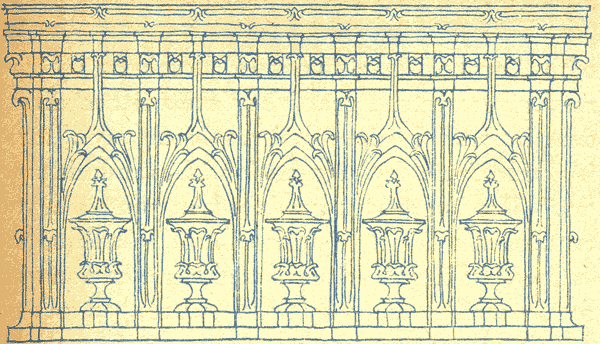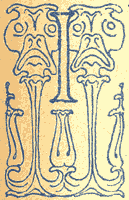| Home -> Ricardo J. Orozco -> The Court of Ages - The Court of Ages | |||
 |
|||
|
The Court of Ages
 It is with sensations of pure delight that I recur for a brief period to the hours I spent in the peaceful shelter of the Court of Ages. It is with sensations of pure delight that I recur for a brief period to the hours I spent in the peaceful shelter of the Court of Ages.It was such a pleasant relief to be able to interchange the din of the Zone, the movement of the crowd on the avenues, the jostling of the sightseers in the Palaces, with the silence and quiet seclusion of this Court. I doubt if anyone entered it without feeling, to some degree, the restfulness of the place steal over him; or who failed to realize the sweetness and warmth of its peace and serenity. I suppose hundreds of people, three-fourths of them trained journalists, have written descriptions of the Court of Ages; but none of them as far as I have read, gives any true idea of the place; neither will my description, if I write one, for as Goethe says: "there is a wide chasm between one's wishes and his powers." The impression produced on you when you entered the Court of Ages cannot be adequately defined and had nothing whatever in common with that generally caused by architecture; you seemed rather to sense an attractive personality, from which radiated harmony; again, it seemed to be a personified expression of Contentment, from which emanated the very Spirit of Rest. It would be difficult to imagine a place with a more antique air of tranquil seclusion, for, from the soul of the Court, arose a serenity, infinitely beyond the expression of any other joy. It had the power to draw each beholder into its harmony, and, of all the beautiful things with which builders and sculptors adorned this marvelous realization of a "Dream City" - not one spoke so powerfully to visitors of all nations - as this lovely Court of Ages. Roofed by the most transparent and enchanting sky that ever smiled on the eye of man; with such an atmosphere of poetic refinement and artistic perfection pervading the place, it was only after a long time that one felt inclined to analyze and search for a material cause for this emotional appeal. As a rule, architecture which reflects the luminous serenity of antiquity, with its perfect rhythm and its logical forms, cannot render the vague, infinite, and mysterious meaning of Christianity; to successfully blend the unchangeable happiness of paganism with the melancholy of Christianity is an artistic triumph seldom achieved; yet there in the Court of Ages we found an ideal cloister, with an ecclesiastically picturesque enclosure, in which a Christian could be as happy as a philosopher. In a general way, when you entered this Court, and beheld the scene of extreme loveliness spread out before you, the principal features of the design commanded your attention; the unity and simplicity of the beautifully proportioned colonnade, which continued in an unbroken line around the four sides of the Court; the wonderful fountain in the scented heart of the garden, encompassed by grounds on which had been expended all the marvelous art of landscape gardening, for which the entire Fair was justly famous; the exquisitely beautiful tower, upon which you fairly riveted your eyes, for it was the crowning glory of all the glories of the Court of Ages. After gazing spellbound with the appealing beauty of the picture, you gradually began to notice the delicacy of ornament blossoming over the main features of the design; all the delicate, graceful details of a Renaissance which Mullgardt knew so well how to apply; the richness of color blending in the landscape against the warm ivory, pink and blue of the background an adorable inspiration! However, to analyze the beauties of this Court, was only to add another note to one's joy in it, their quality and rarity being of such an order as to warrant one's cooler admiration. Just as "Beauty is only irresistible when it shows us something less transitory than itself; when it makes us dream of that which charms life beyond the fugitive moment which seduces us," so, the Court's distinction was a thing apart from its beauty. One discovered that this beautiful decoration of sculptured ornaments, which seemed to flower out spontaneously as natural incidents of the exquisite design, was replete with a most complex symbolism - embodying allegories in sculpture, covering many periods of progress in the evolution of life; or, as Mullgardt says - an historical expression of the successive ages of the world's growth. The first stage of the plan was depicted by the fountain, the braziers and cauldrons, the figures on the pedestals each side of the tower entrance, and by Brangwyn's glorious murals, which hung within the colonnade, all of which were to suggest - the nebulous world, Earth, Air, Fire and Water. In the ornamentation of the Arcade, we found the second period, a transition from plant to animal life - cleverly indicated by sea vegetation, sea animal and shell motifs. The third stage was illustrated with the earliest forms of life associated with the Stone Age, and we saw figures representing primitive man and woman arising from the piers of the arcade, and also demonstrated through the first sculptured group over the entrance to the tower. The dawn of Christianity, symbolizing the fourth stage, was represented by the ornamented finials surrounding the Court, and this period was epitomized and idealized in the aspiring tower. As the ages roll on there is also a progression in human nature. The intellectual comes to rule the physical; it is no longer strength of body that prevails, but strength of mind, and Lo! we have at last lived to see Intelligence enthroned on high in a Cathedral tower. As an architectural monument - the tower is an unique, original assemblage of art elements belong-to many different epochs, and, as such, shows, as well as any other document of contemporary times, the varying ambitions and emotions of the various builders in the whole history of architecture. To the visitor of cultivated taste and historic knowledge - the Court of Ages was therefore endlessly interesting; the great wealth of detail in the symbolism, with its reminders of all human life that since the early dawn of the world has peopled the earth, gave one many subjects of reflective interest of the highest order and widest range. But the mind that can reverence historic association needs no explanation from me of the interest and charm that such associations possess. As for me - my whole meagre outfit of memory, of poetic equipment and imaginative furnishing, was quite unequal to the demands of a perfect survey. It took me a bug time before I was able to trace the varying elements of symbolism in any degree as plainly as the writers who have described them in the guide books; and it required both effort and study to perceive the relation of the many symbols to their respective periods of progress; the wonderful fountain in the center of the Court, which was considered one of the curiosities of the place, and of which some people spoke with almost hyperbolical admiration, was to me, at first, only a fountain. And even if I had never learned about the inner meaning, of which all this design reflected the mere image and expression, I should have been most strongly impressed by the Court's singular appeal to one's heart and sensibilities. The truth of the matter is, that I lost my heart to the beauty of this Court, and I cared little or nothing for a clever dissecting of its component parts. What most deeply concerned me was the desire to secure an uninterrupted session of contemplative enjoyment in the midst of it. I went again and again, and, after all, it was not the clever symbolism which drew me, it was the glory of the Court as a whole, its tender impressiveness, its pensive restfulness, the happy mystic poetry of it in the evening, that charmed and entranced me. It was so full of an Old World charm, just the right quality of richness and completeness to evoke an intense and personal sympathy. |
|||